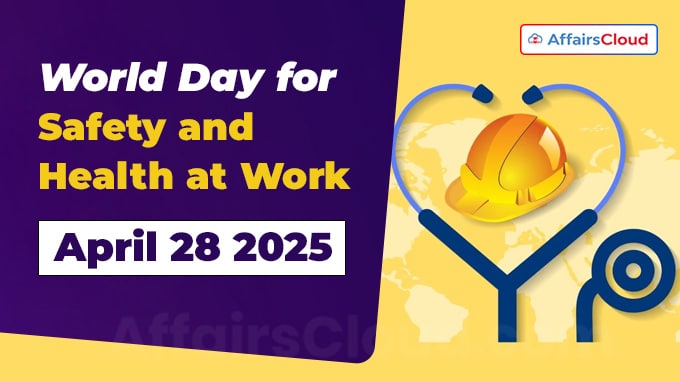 World Day for Safety and Health at Work is observed annually across the globe on April 28 to promote safe workplaces, reduce work-related accidents and diseases, and advocate for Occupational Safety and Health (OSH) standards globally.
World Day for Safety and Health at Work is observed annually across the globe on April 28 to promote safe workplaces, reduce work-related accidents and diseases, and advocate for Occupational Safety and Health (OSH) standards globally.
- The annual observance of the Day is spearheaded by the International Labour Organization (ILO), a specialized agency of the United Nations (UN), dedicated to promoting social justice and advancing internationally recognized human and labour rights.
2025 Focus:
The Focus of World Day for Safety and Health at Work 2025 is “Revolutionising Health and Safety: The Role of AI and Digitalisation at Work“.
- It aims to showcase the transformative impact of Artificial Intelligence (AI) and digital technologies on enhancing OSH across workplaces globally.
Background:
i.ILO established the World Day for Safety and Health at Work in 2003 during the International Labour Conference(ILC), coinciding with the adoption of the Global Strategy on Occupational Safety and Health, which emphasized advocacy for promoting workplace safety and health standards.
ii.The first-ever World Day for Safety and Health at Work was officially observed on 28th April 2003.
Note: April 28 is also marked as the International Commemoration Day for Dead and Injured Workers, honoring workers who have lost their lives or suffered injuries in the workplace. It has been globally recognized since 1996 through the efforts of the International Confederation of Free Trade Unions (ICFTU).
ILO Declaration on Fundamental Principles and Rights at Work:
i.The ILO Declaration on Fundamental Principles and Rights at Work, initially adopted in 1998 and later amended in 2022.
ii.This Declaration represents the unwavering commitment of governments, employers, and workers’ organizations to uphold basic human values, values that are essential to social justice and economic progress.
Significance:
i.Globally around 2.78 million workers die annually due to work-related accidents or diseases, with 317 million non-fatal injuries reported each year.
- These incidents cost nearly 4% of global Gross Domestic Product (GDP) (around USD3.61 trillion) in economic losses.
ii.The day reinforces the ILO’s Global Strategy on Occupational Safety and Health (2024–2030), which integrates tripartism (collaboration between governments, employers, and workers) to build a preventive safety culture.
Prevention of Occupational Accidents and Disease:
i.Global Strategy: The ILO advocates for national policies, robust inspection systems, and worker education to mitigate risks.
ii.Emerging Risks:
- Technological Changes: Nanotechnology, biotechnology, and automated systems
- Work Arrangements: Gig economy jobs, telework, and temporary contracts
- Psychosocial Factors: Stress from excessive workloads or algorithmic monitoring
Workplace Safety and Health in India:
In India, labour is placed under the Concurrent List of the Indian Constitution, allowing both the Central and State Governments to legislate on workplace safety. Key institutions include:
i.Directorate General Factory Advice Service and Labour Institutes (DGFASLI): Under the Ministry of Labour and Employment (MoL&E), it oversees factory safety.
ii.Occupational Safety, Health and Working Conditions Code (OSH Code), 2020: Consolidates 13 labor laws, including:
- Factories Act, 1948
- Mines Act, 1952
- Building and Construction Workers Act, 1996
iii.Directorate General of Mines Safety (DGMS): Regulates mining safety protocols.
iv.Employees’ State Insurance Corporation (ESIC): Provides health insurance for workers.
About International Labour Organization (ILO):
Director-General (DG) – Gilbert Fossoun Houngbo
Headquarters – Geneva, Switzerland
Established – 1919




